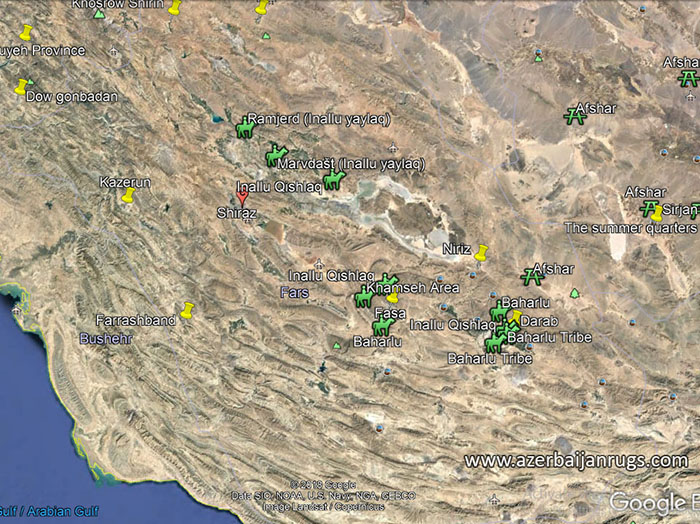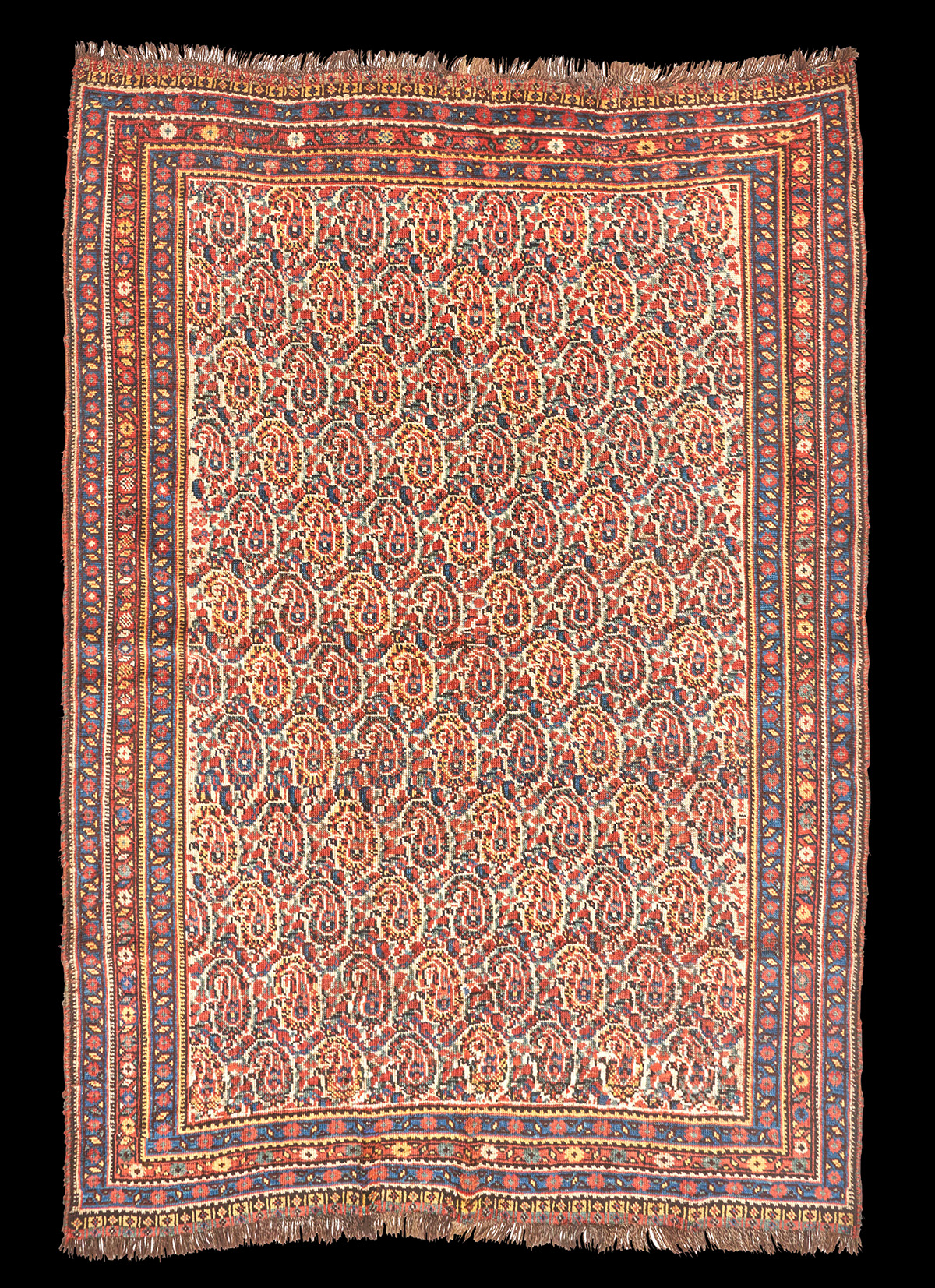|
Antique Khamseh Barahlu
tribal rug in an ivory ground
Code:
WKHB02
Age: c 1890
Size: 130x185cm
Size (ft): 4'3"x6'1"
Structure: wool pile, brown and ivory wool warps
twisted and
red wool wefts.
Knots: Gördes (Turkish, symmetrical)
Condition: Good even pile. Original selvedge. Overall well preserved.
The ends are secured. All natural colors. Ask for more photos
vd@azerbaijanrugs.com
Design: A 130-140 years old
antique Khamseh carpet woven with all over botehs on scarce ivory ground.
Good natural dyes. Acquired from a prominent private collection in
USA.
The rug was woven in the late 19th century in the south east of Shiraz,
by Baharlu tribe of the Khamseh confederation.
Notes on Baharlu tribe of Khamseh Confederation: Khamseh was
consisted of mainly Turkic tribes (Inallu, Baharlu and Nafar) of Shiraz
(Fars) province, and partly Arabs of mixed origin. Basseri, which is also
one of the Khamseh tribes are descended from Arabic, Persian and Turkish.
Baharlu (Aynallu, Ainalu, Inalu, Inanlu) is a tribe of Oghuz Turkic
origin who settled in Azerbaijan and Iran in the early 15th century.
Today, they mainly live in Fars, Azerbaijan, Khorasan and Kirmān provinces
of Iran.
According to J. Malcolm, it was originally a branch of the Shamlu tribe,
“who were brought into Persia from Syria by Timur” (The History of Persia,
London, 1829, I, p. 237).
V. Minorsky believed that Baharlu was
another name for the Barani (or Baranlu) tribe, which was the tribe of the
Qara Qoyunlū ruling dynasty (15th century), and that the tribe was an
offshoot of the Īvā (Yiva) tribe, which was one of the 24 basic Oghuz
divisions (“The Clan of the Qara-Qoyunlu Rulers,” in Mélanges Fuad
Köprülü, Istanbul, 1955, p. 391; idem, “Baharlu,” in EI2 I, p. 919).
From all the information available, it appears that the Baharlu tribe
joined the Qara Qoyunlū tribal confederacy only after the latter had
already been formed, most probably following the conquest of Hamadān by
Qarā Yūsof in 1408.
According to tribal tradition, Baharlu tribe
of Fars region came from Azerbaijan. But the fact that one of their tīras
(clans) is called Mašhadlū suggests that they were among those Baharlus
who fled to Khorasan following the collapse of the Qara Qoyunlū state.
Some researches claim that they settled in Fārs in the 18th-19th
centuries. But this could not be the case if they came from Khorasan. One
is tempted to believe that both the Bar-e Baharlus of Kermān and the
Baharlus of Fārs are descendants of the Baharlus who were abandoned in
Sīrjān when Pīr-ʿAlī Beg and his brother Bayrām Beg were defeated by
Sultan Yaʿqūb Āq Qoyunlū in 1478, for the Bar-e Baharlus have settled down
in Sīrjān and the Baharlus of Fārs have established themselves in an area
immediately to the southwest of that region.
Until 1860s, the
Baharlus of Fārs were fully nomadic. Their summer quarters were in the
districts of Rāmjerd, Marvdašt, and Kamīn, north of Shiraz, and their
winter quarters were around Darab and Izadkhast, in southeastern Fars
(Fasāʾī, II, p. 310). M. L. Sheil estimated their number at 1,230 families
in 1849 (Glimpses, p. 399); K. E. Abbott at 2,000 families in 1850 (“Notes
Taken on a Journey Eastwards from Shiráz . . . in 1850,” JRGS 27, 1857, p.
153). Their last important leader was Molla Ahmad Khan Bozorgi of the
Aymadlu clan, who ruled between 1851 and 1859 (Fasāʾī, II, pp. 310-11).
Upon his death, a fierce struggle for power ensued. Massacre followed
massacre. So great were the losses in human life that the tribe was never
again able to recover its former strength and the tribesmen decided that
they were no longer numerous enough to participate in the lengthy seasonal
migrations to which they were accustomed. The remaining Baharlus settled
down in their winter quarters and eked out a living from a mixture of
agriculture and pastoralism, as well as from the proceeds of banditry. L.
Pelly, who visited them in the early 1860s, wrote that they “are very
mischievous and a set of robbers, who by killing each other have put an
end to themselves and their ketkhodas, and all that remains of them are
some horsemen, who wander about plundering everyone that comes in their
way” (“Brief Account of the Province of Fārs,” Transactions of the Bombay
Geographical Society 17, 1963, p. 183). Similar observations were made by
H. B. Vaughan (“A Journey Through Persia, 1887-88,” Royal Geographical
Society; Supplementary Papers III/2, 1892, p. 97), A. T. Wilson (South
West Persia . . . 1907-1914, London, 1941, p. 47), G. Demorgny (“Les
réformes administratives en Perse,” pt. 1, RMM 12, March, 1913, p. 103),
P. M. Sykes (A History of Persia, 3rd ed., London, 1951, II, p. 479), and
others. Their exploits as bandits are also described in Waqāyeʿ-e
ettefāqīya.
In 1861-62, the tribe was absorbed into the Khamsa
tribal confederacy, which was formed by the governor-general of Fars,
Soltan Murad Mirza, in an endeavor to check the growing influence of the
Qashqai tribal confederacy (P. Oberling, The Qashqāʾi Nomads of Fārs, The
Hague, 1974, p. 65).
In 1933 the Baharlu tribe of Fars comprised
8,000 families forming twenty tiras (branches): Ibrahimkhani, Aḥmadlu,
Ismailkhani, Burbur, Bakla, Jambozorgi, Jarga, Juqa, Haji attarlu,
Haydarlu, Rasulkhani, Saqqiz, Shafikhani, Isabeglu, Karimlu, Kolahpusti,
Mashadlu, Naserbeglu, Warata (Kayhan, Jogrāfīā II. p. 86).
Since
World War II, the Baharlūs have become completely sedentary, living the
year round in the dehestāns (subdistricts) of Fasārūd, Ḵosūya and
Qarīat-al-Ḵayr in the baḵš (district) of Dārāb (Razmārā, Farhang VII, pp.
88, 165, 171). O. Garrod, a British physician who visited Fārs toward the
end of the war, noted that the Baharlus were “fast losing their tribal
organization and characteristics” (“The Nomadic Tribes of Persia To-Day,”
Journal of the Central Asian Society 33, 1946, p. 44) and concluded: “The
Baharlus, once the foremost horsemen and more feared warriors and bandits
of Eastern Fārs, have sadly degenerated from the effects of Malaria and
the diseases bred in the cumulative filth of their settlements” (ibid.).
By 1957, the tribe’s population had dwindled to a mere 4,000
individuals (personal interview with Amir Aqa Khan Baharlu).
|

Baharlu living areas in Shiraz/Fars province
|
|



